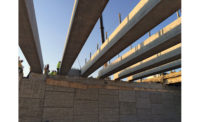A multidisciplinary team is set to begin surveying and inspecting 400 bridges across the U.S. in the first five-year phase of a Federal Highways Administration-funded Long-Term Bridge Performance program that aims to create a high-quality database on bridge performance.
Led by the Rutgers Center for Advanced Infrastructure and Transportation (CAIT) and Parsons Brinckerhoff, New York City, the team eventually hopes to narrow the 400 bridges down to 20 for high-tech instrumentation and monitoring, says CAIT Director Ali Maher, the contract’s principal investigator.
The Rutgers-led team includes the Utah Transportation Center at Utah State University; the Virginia Transportation Research Council, University of Virginia and Virginia Tech; the Institute of Transportation Studies at the University of California, Berkeley; Princeton, N.J.-based Siemens Corporate Research; Boulder, Colo.-based Bridge Diagnostics, Inc. and French firm Advitam. It responded to a Request for Proposals in 2007 and won the contract late last year. The initial five-year contract, worth up to $25.5 million, may be the first phase of an ultimately 20-year research project. Congress approved funding for it in 2005 under the Safe, Accountable, Flexible, Efficient Transportation Equity Act: A Legacy for Users.
The team will look only at urban highway bridges less than 50 years old and over 20 ft long, notes Andrew J. Foden, PB supervising engineer. It is not looking at signature or large-scale bridges such as suspension and cable-stayed crossings. “The focus is on the most mundane yet most numerous ‘workhorse’ bridges,” says Maher. “We want to contribute to the understanding of bridge performance and ultimately help owners to better evaluate their goals.”
He emphasizes that the study is not intended to directly tackle the issue of the I-35W bridge collapse in 2007, nor to create a specific program or tool. “Rather, we want to create a lot of quality data” that highway departments can use to make better decisions. The aim is to create improved life-cycle cost and predictive models, better understanding of bridge deterioration and more effective maintenance and repair strategies. “We want to get away from the “worst first” approach, says Foden. “Currently, the bridge in the worst shape gets the fix first. The idea here is to find the optimum time as to when and how often to [for example] repaint the steel or replace the deck.”
For the remainder of this year, the team will work on the initial development phase. It will choose the 400 bridges to visually inspect, and create the infrastructure for a data management model. The bridges will represent a range of common conditions — i.e., extreme climates and various corrosion and hazard factors — and be chosen in part based on the documentation provided by state transportation departments.
The pilot program will include the visual inspections. PB will draw upon its existing engineering contracts around the country to help inspect the 400 bridges, notes Foden. Four bridges will be guinea pigs to test the new system of collecting and mining data. They and 16 others will receive instrumentation and other non-intrusive monitoring, contingent on further funding after a report is made to Congress in 2012.



